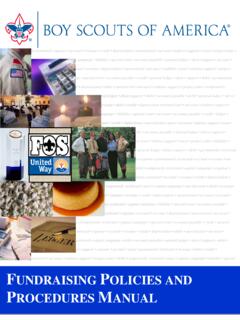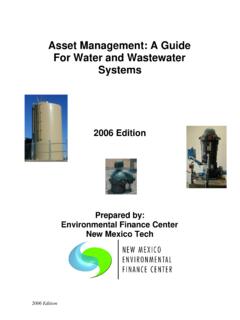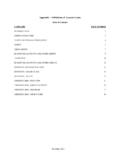Transcription of GASB Statement #34 Capital Assets & Depreciation Guidance
1 GASB Statement #34 Capital Assets & Depreciation GuidanceAugust 31, 2001 Page 1 of 14 The following questions and answers are intended to be informative only, not government entity may face different issues/situations that should be resolved basedon the particular facts, circumstances, and materiality levels of that Capital Assets DefinitionCapital Assets include: land, land improvements, buildings, building improvements, constructionin progress, machinery and equipment, vehicles, infrastructure, easements, and works of art andhistorical treasures. A Capital asset is to be reported and, with certain exceptions, depreciated ingovernment-wide statements.
2 In the government-wide statements, Assets that are not capitalizedare expended in the year of Assets are long-lived Capital Assets that normally can be preserved for a significantgreater number of years than most Capital Assets and that are normally stationary in include roads, bridges, tunnels, drainage systems, water systems, and Assets do not include buildings, drives, parking lots or any other examples givenabove that are incidental to property or access to the Information Needed for an inventory RecordGovernmental entities should develop strategies to ensure they have an accurate, complete, andup-to-date record of Capital Assets .
3 Each government entity should have such an inventorybeginning in 1980 when NCGA Statement created the General Fixed asset Account and accuracy should be ensured through physical counts, review of purchaserecords, prior inventory count records, listings maintained by other government agencies, andother methods deemed entities will need to devise a method to determine historical costs or estimatedhistorical cost of Capital Assets on hand. Future asset acquisition will be valued at the acquisitioncost for purchased items and donated items will be capitalized at fair market value on thedonated governmental entity should have an inventory of all Capital Assets .
4 Each inventory recordshould include: description, year of acquisition, method of acquisition ( , purchase, donation,etc.), funding source, cost or estimated cost, salvage value, and estimated useful life. Theinventory record will also need to identify the function(s) that use the Statement #34 Capital Assets & Depreciation GuidanceAugust 31, 2001 Page 2 of 143. Recording LandLand is to be capitalized but not depreciated. It is recorded at historical cost and remains at thatcost until disposal. If there is a gain or loss on the sale of land, it is reported as a special item inthe Statement of Recording Land ImprovementsLand improvements include items such as excavation, non-infrastructure utility installation,driveways, sidewalks, parking lots, flagpoles, retaining walls, fencing, outdoor lighting, andother non-building improvements intended to make the land ready for its intended improvements can be further categorized as non-exhaustible and - Expenditures for improvements that do not requiremaintenance or replacement.
5 Expenditures to bring land into condition tocommence erection of structures, expenditures for improvements not identifiedwith structures, and expenditures for land improvements that do not deterioratewith use or passage of time are additions to the cost of land and are generally notexhaustible and therefore not - Other improvements that are part of a site, such as parking lots,landscaping and fencing, are usually exhaustible and are therefore of site improvements is necessary if the improvement is Recording BuildingsBuildings should be recorded at either their acquisition cost or construction cost.
6 The cost ofnew construction should be carefully evaluated. Usually projects consist of major componentssuch as land, land improvements, building construction (including professional fees and permits),furniture, fixtures and equipment. In addition, buildings include components ( , roof, airconditioner system, etc.) that should be recorded separately when significant because thesebuilding components have different useful lives. The value of each component needs to bedetermined and placed within its own Recording Building ImprovementsBuilding improvements that extend the useful life should be capitalized.
7 Governmental entitiesshould therefore review major maintenance projects for the last several years to determine thosethat should become part of the restatement of Assets for purposes of complying with Statement #34 Capital Assets & Depreciation GuidanceAugust 31, 2001 Page 3 of 14 Examples of building improvements include roofing projects, major energy conservationprojects, or remodeling and replacing major building components. A governmental entity willneed to determine the practicality of identification of these projects and prepare an inventory will need to include a project description, the year completed, funding source anddollar amounts.
8 Only those projects that meet the capitalization threshold need to be , as a practical matter, governmental entities should establish a cut off date for retroactiverecognition of site and facility improvements. It is recommended that governmental entitiesreview projects for the last three to five years unless meaningful data are readily availablefor preceding Recording Construction in ProgressConstruction in progress should be capitalized and not depreciated. It should be reported withland and other non-depreciating Assets at the government-wide level. Unspent debt proceedsfrom Capital Assets related debt should be reported in the net Assets section of the Statement of netassets as restricted for Capital projects.
9 8. Recording Machinery and EquipmentAssets such as furniture, machinery and equipment (that meet threshold levels) should beidentified and inventoried. Some Assets , individually, may fall below the capitalization thresholdbut may be purchased in large quantities by the governmental entity. Examples include librarybooks, textbooks and computers. Governmental entities should aggregate such Assets andconsider the materiality and significance of them and if material or significant capitalize suchitems either individually or in the aggregate. (See question number 12 for applying thresholdlevels.)
10 9. Recording Library BooksIf library books are considered to have a useful life of greater than one year, they are capitalassets and are depreciable. Because most library collections consist of a large number of bookswith modest values, group or composite Depreciation methods (as discussed in DepreciationMethods to Calculate an asset 's Depreciation ) may be appropriate. In certain situations, librarybooks may be considered works of art or historical treasures and could be reported using thoseprovisions (see Recording Works of Art and Historical Treasures).10. Recording VehiclesVehicles should be identified, inventoried, and if applicable Statement #34 Capital Assets & Depreciation GuidanceAugust 31, 2001 Page 4 of 1411.
















